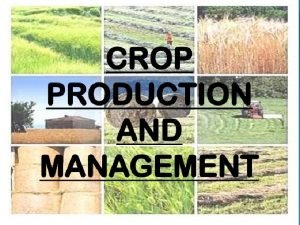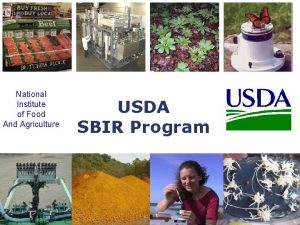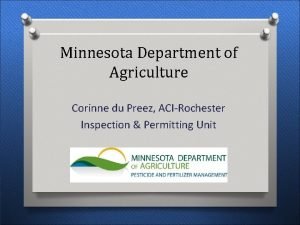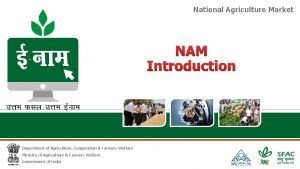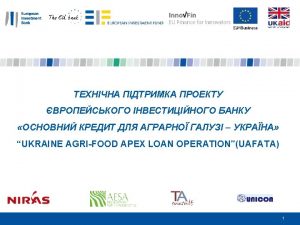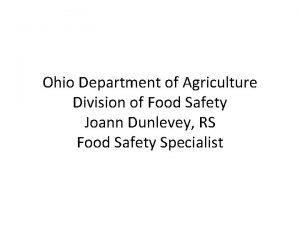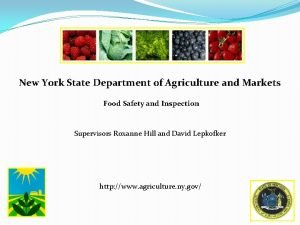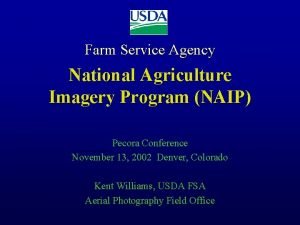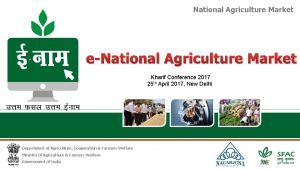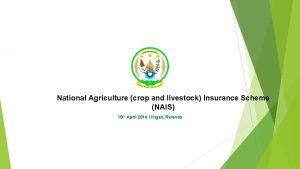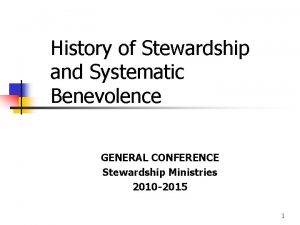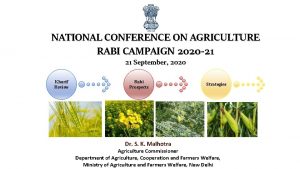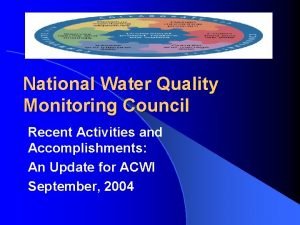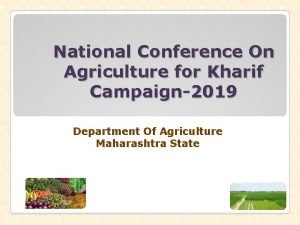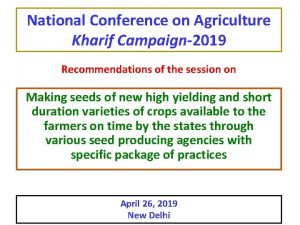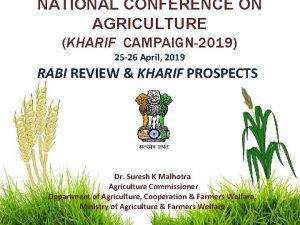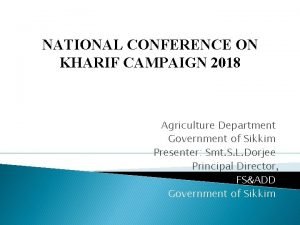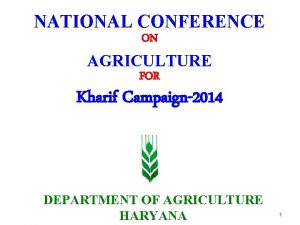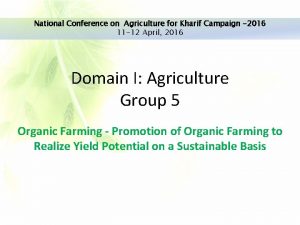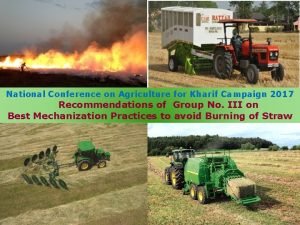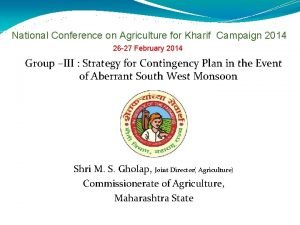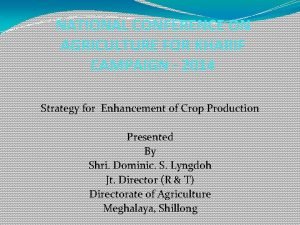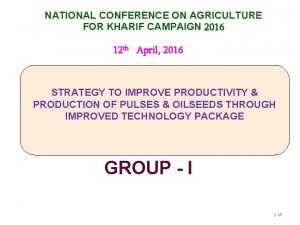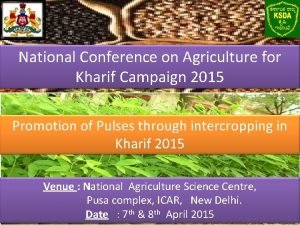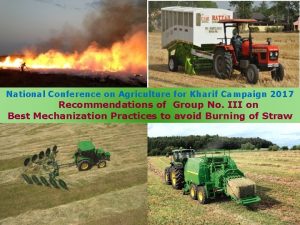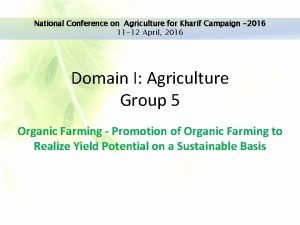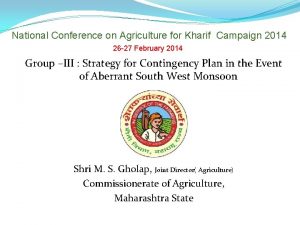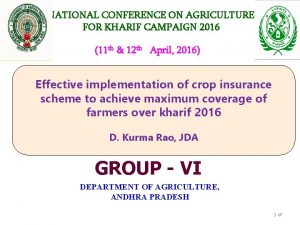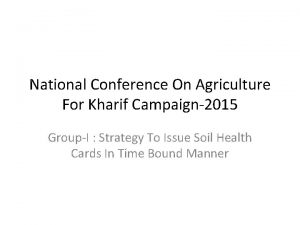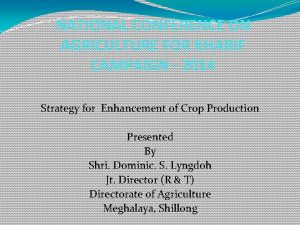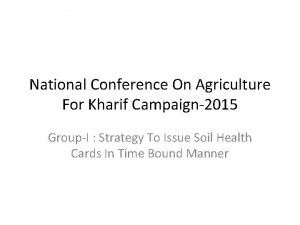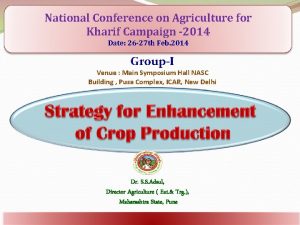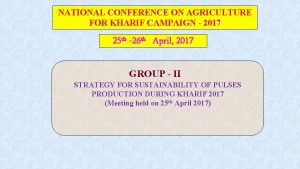National Conference On Agriculture for Kharif Campaign2019 Department











































- Slides: 43

National Conference On Agriculture for Kharif Campaign-2019 Department Of Agriculture Maharashtra State

State Initiatives Ø Maha. AGRITECH Ø PBW Management strategies Ø CROPSAP linked FFS Ø Jalyukt Shivar Abhiyan Ø Magel tyala shet tale (Farm Pond On Demand) Ø Group farming

Maha. AGRITECH • • Background Maha. AGRITECH Phase-I Study CROP ACREAGE for Phase-1 Districts Crop Mapping Condition & Yield Prospects Phase-II Study Modules of Maha. AGRITECH 30 -11 -2020 3

Background (1 of 2) • • • Natural calamities such as droughts, floods, abnormal weather events and biotic risks like pests and diseases continue to affect the agriculture adversely. Crop yield variability is ever increasing and has become a serious challenge to bring stability to farm production. Agriculture involving innumerable decisions amidst intricate complexities at all levels from farmers to planners needs the support of technologies. Technology interventions in agriculture is the only way-out to address ever-increasing challenges in this sector such as cultivation risks – weather, pest/diseases, large yield gaps, inconsistent yield levels, increasing cost of cultivation – inputs, low and un-realisable MSP, non-remunerative market prices, poor market infrastructure and poor penetration of crop insurance etc. In order to address the challenges of agriculture sector department wanted to use Satellite imaging / Drone technological solutions. Department has contacted and gained understanding from various organizations, education institutions and start-ups/agencies that work on the technologies of satellite imaginary, drones and GIS mapping for agriculture. 30 -11 -2020 4

Background (2 of 2) • Post extensive research department has chalked out implementation plan for the use of Satellite and drone technology in the agriculture sector. • Institutions involved include: • • ISRO NRSC BAMU, Aurangabad GIPE, Pune Agriculture Universities of Maharashtra Po. CRA MRSAC • Department entrusted MRSAC & NRSC to address the challenges by launching Maha. AGRITECH project 30 -11 -2020 5

Maha. AGRITECH • • • Maha. AGRITECH was formally launched on 14 th Jan 2019 by Chief Minister of Maharashtra To Assess Crop Acreage, Condition & Production using Integrated Geo-ICT Technologies and Development of User friendly Dashboards for Agriculture Decision Support In Maharashtra Phased approach for implementation of Maha. AGRITECH. – Phase-1: Covering 6 talukas of 5 divisions (Pilot Project). – Phase-2: Covering Major Field crops & Major Horticulture crops of entire Maharashtra Objectives of Phase-1 Maha. AGRITECH • Satellite based Crop Mapping (selected Kharif crops) and inventory at Circle and District level. • Monitoring crop prospects with satellite derived indices. • Crop yield modelling (semi empirical / process based) for pre-harvest assessment of crop yields for major crops 30 -11 -2020 6

Phase-I Study • Phase wise execution • In phase-I, 6 districts from different agriculture divisions are selected • Considered extended Kharif crops - Cotton, Tur & Rabi crops - Sorghum, Maize, Wheat & Grams # Division District 30 -11 -2020 Taluka Extended Rabi Crops Kharif Crops 1 Aurangab Beed ad Ambejoga i Cotton, Tur Sorghum 2 Pune Solapur Mangalve dha - Sorghum 3 Nagpur Mauda Cotton, Tur Wheat, Gram 4 Amravati Buldhan a Buldhana Cotton, Tur Wheat, Gram 5 Nashik Jalgaon Cotton Gram, Maize 6 Aurangab Latur ad Renapur Tur Wheat, Gram 7

Remote Sensing based CROP ACREAGE for Phase-1 Districts S N DISTRICT SLECTED KHARIF CROPS Cotton + Tur SELECTED RABI CROPS Rabi Sorghum Wheat Gram 1 Nagpur 317019. 26 52760. 87 68843. 36 2 Buldana 239948. 68 21350. 31 3 Jalgaon 443789. 63 4 Beed 317019. 26 5 Latur 6 Solapur Rabi Maize 106272. 1 8 41135. 22 21046. 36 56190. 50 91335. 6 3 85944. 77 235957. 75 Not Selected for the study 30 -11 -2020 8

Crop Mapping Kharif 2018 -2019 (Cotton + Tur) Beed 30 -11 -2020 Buldhana Nagpur 9

Crop Mapping Kharif 2018 -2019 Cotton - Jalgaon 30 -11 -2020 Tur - Latur 10

Crop Mapping Kharif 2018 -2019 Rabi Sorghum - Solapur 30 -11 -2020 Gram - Latur 11

Change Detection of Tur Crop compared to previous year Latur District (Ganjur village of Latur Taluka) 30 -11 -2020 12

Crop Condition & Yield Prospects +/-10% NDVI Deviation >-10% -10 to 20% -20 to 30% -30 to 40% <-40% Normal Mild LSWI Deviations -30 to -10 to -20% -20 to -30% <-40% Modera Normal Mild Moderate te Moderate Moderate Severe Rainy days deviation Moderate -40 to Severe Rf deviation >20% 20 to -20 %-20 to -40% 60% <-60% Moderat >20% Normal Mild e Moderat 20 to -20 % Normal Mild e Moderat -20 to -40% Mild Moderate e Moderate NDVI_LSWI_Rainfall_Rainyda -40 to -60% Moderate Severe ys Matrix <-60% Moderate Severe NDVI & LSWI Normal Mild Moderate Severe Dev Normal Mild Moderate Mild Normal Mild Moderate Severe Moderate 30 -11 -2020 Moderate Severe • • Based on the (LSWI & NDVI) and (Rainfall & Rainydays) composite index is developed to assess crop condition and crop yield. Deviations are calculated taking 2017 -18 as a base year 1. Normal - Similar to that of 2017 -18 2. Mild - Crop condition is slightly poor compared to 2017 -18. (About 10 -20% reduction in crop sown area or crop yield or both are expected) 3. Moderate - Crop condition is poor compared to 201718. (About 20 -30% reduction in crop sown area or crop yield or both are expected). 4. Moderate to Severe - Crop condition is significantly poor compared to 2017 -18. (More than 30% reduction in crop sown area or crop yield or both are expected) Disclaimer: The drought impact classes are indicative in nature. More detailed analysis is to be carried-out to validate and improve the methodology. 13

Crop Condition & Yield Prospect Map 30 -11 -2020 14

Phase-II Study • Phase-2 will commence from June 2019 • Covers all Major Field crops & Major Horticulture crops in Maharashtra Objectives of Phase-2 Maha. AGRITECH • Development of Crop planning tools: Crop suitability assessment based on soil, weather, water resources, watershed development, cropping pattern, crop yield estimates, market trends etc. • Crop mapping and inventory at circle and district level and provide maps and statistics during the season (covering major field crops and total crop area for kharif and rabi seasons). • Crop mapping and inventory of major Horticulture crops • Development of crop surveillance system with Mobile apps (CROPSAP), Weather data (AWS) and satellite based indices and analytics for providing the crop condition information and advisory services periodically during the season. • Development and management of Drought Monitoring System (Maha. MADAT) – providing drought indices to support drought declaration. • Crop yield modeling (semi empirical / process based) for pre-harvest assessment of crop 30 -11 -2020 yields/indicative crop yields for major crops. • Development of geospatial database of soil nutrient parameters based on Soil Health Card data to facilitate advisory services. • Crop insurance solutions - Monitoring the insurance coverage based on insurance and cadastral data, risk index for clustering, CCE data analysis, feasibility studies for implementing the smart sampling techniques • Crop and weather data – Creation of time-series database on (a) area, yield and production of different crops, (b) market data and (c) rainfall and development of visualisation and analysis tools • Asset inventory - Analysis of geo tagged assets created under different schemes (RKVY, PMKSY, MIDH, MTS, JSA etc. ) and generation of value added information products for decision support • Beneficiary farmers: Cadastral level mapping of farmer-beneficiaries of various schemes and generation of value added information products 15

Phase-II Study # Division % TGA 1 Amravati 46079. 71 15. 00 2 Aurangabad 28383. 74 9. 24 3 Kolhapur 26749. 20 8. 71 4 Konkan 30268. 82 9. 86 5 Latur 36287. 19 11. 82 6 Nagpur 51365. 94 16. 73 7 Nashik 40449. 80 13. 17 8 Pune 47525. 45 15. 48 307109. 85 100. 00 TGA 30 -11 -2020 Area (Km 2) 16

Modules of Maha. AGRITECH • Crop Mapping • • Ground Truth Collection Mobile Application Solutions for Smart CCE Application Agriculture Grievance Redressal system Application for Farmers • Crop Surveillance Predictive • Sowing intelligence Analysis • Early season crop • forecast Drought Analysis Crop Health mapping Water Stress Assessment Crop Damage Assessment • • • Maha. AGRITECH CCE Planning/Optimiza Crop Yield & tion Production • Crop Yield Estimation • Seasonal Crop Production Estimation Alternate crop suitability planning • Commodity wise Demand & Supply Estimation Agri Market Demand & Supply Analysis estimations for Agri-Inputs Site-Suitability for agri products storage 30 -11 -2020 Crop Acreage using satellite images Crop Sown Area • • Optimum fertilizer recommendations 17

Crop Mapping INPUTS Crowd sourcing inputs Integration with CROPSAP Agriculture Assistants inputs Processed moderate resolution multisensory satellite data Conventional and machine learning algorithms Crop Mapping and an attempt to map orchard and pastures This module is mainly aimed at: - Identification of crops at district/ taluka/village using crop signatures - Collection of crop information such as crop variety, irrigation source, crop sowing dates, photos of field etc. 30 -11 -2020 18

Crop Surveillance Crop Health Monitoring Processed moderate resolution multisensory satellite data Crop Water Stress Mapping Integration with CROPSAP and Mahawedh Drones may be used to access localized calamities 30 -11 -2020 – Algorithms to derive multiple periodic indices for vegetation, drought etc. – Water budgeting models Crop Loss/ Damage Assessment 19

Crop Yield & Production Estimation Processed moderate resolution multisensory satellite data Historical data Indices from crop surveillance Crop Acreage Algorithms Optimization & Planning of Crop Cutting Experiment 30 -11 -2020 (CCE) Sampling Crop Yield Estimation Seasonal crop production estimation 20

Predictive Analysis ► Past Present Near Future Sowing Intelligence Draught Analysis Alternate Crop Sustainability Analysis Deviation in sowing pattern to be analysed by integrating the historical satellite data and various weather parameters 30 -11 -2020 ► Conditions for natural calamities will be monitored in comparison with historic data available ► Integration of existing Maha. Madat and Mahavedh applications ► Land suitability for alternate crops analysed by using various parameters such as topography, soil type, weather, irrigation facility etc. ► Existing applications of soil health card, watershed bodies, ground water availability etc. , may be integrated Known Future Unknown Future Early season crop acreage forecast ► High resolution data with high repeativity helps to identify and forecast the early season crop sown area which helps in implementing the departments contingency plan with in a season Optimum Fertilizer recommendation ► Soil health card may be integrated with latest Cadastral data may help in providing optimum recommendation of fertilizers 21

Agri-Market Analysis 30 -11 -2020 22

Mobile Solutions 12 345 Ground Truth Collection Application Mobile Application for collection Ground Truthing Information - Crop location, Pests & Disease, Irrigation source along with Geotagged photographs. (Existing CROPSAP and Maha. Madat application may be customized, if required to achieve these objectives) 30 -11 -2020 Smart CCE Application Customized Crop Cutting Experiment (CCE) Mobile Application integrated with to provide better CCE planning & execution. Grievance Redressal system To bridge the gap between all stakeholders and increase transparency Integration with the Aaple Sarkar application Application for Farmers open discussion forum Increased Farm Productivity and Ease of doing Agriculture can be achieved by a Mobile application that provides farmers timely information about weather, crop health, disease probability, fertilizer recommendation, warehouse locations, market rates, procurement centers, etc. Web based dashboard for government To assess the current nature of agriculture across the state and take preemptive and corrective measures when required 23

PBW MANAGEMENT STRATEGIES Comprehensive strategies finalized under below four verticals Administrative Strategies Legal Strategies Technical Strategies ICT Strategies 24

PBW MANAGEMENT STRATEGIES Administrative Strategies • Intervention strategies were finalized in advance of the season and pest management strategy revised based on pest status • Constitution of District Level Monitoring Committee under District Collector for regular review of pest status and activities implemented in the district. • Appointment of District coordinator from state level to all cotton growing district for assessments of PBW status and monitoring management campaign • Involvement of people’s representatives • Multiple workshops were conducted at State, Division and District level to plan PBW management activities 25

PBW MANAGEMENT STRATEGIES Administrative Strategies • Organization of PBW management demonstrations consisting pheromone traps and Trichogramma bactrae on 100% subsidy on total 20100 hectare area from 201 villages (one village per Taluka) • Subsidy for biological / chemical pesticide was made available @ Rs. 750 per hectare on 50% subsidy. • RAWE students of Agricultural Universities have been involved in PBW campaign to aware the farmers. • Mass awareness is created by arranging Special Gramsabha, village meetings, farmer rallies, pictorial chariot, street plays, prabhat pheris, posters on IPM, timely termination of cotton etc. 26

PBW MANAGEMENT STRATEGIES Administrative Strategies • Special campaign organised in cotton ginneries, cotton storage and market places for sanitation and installation of pheromone and light traps for PBW mass trapping. • Involvement of inputs manufacturers through CSR. Private industries involved in PBW management campaign to use cotton stubbles after harvesting for making fuel briquette/cake so the hibernating pest and diseases in cotton stubbles get destroyed. • Special concentration is given to avoid ratooning. 27

PBW MANAGEMENT STRATEGIES Legal Strategies • Seed sale and its movement were restricted throughout the State up to 21 st May, 2018 under Maharashtra Cotton Seed Act, 2009 to avoid pre seasonal sowing as well as minimize the sowing window • Long durational 35 cotton varieties were banned in the State that serves as continuous hosts of pink bollworm. • Sell of same pesticide by different brand names was restricted • Refugia in Bag (RIB): Bt seed was deployed to avoid resistance development • Stringent Quality Control approaches were deployed 28

PBW MANAGEMENT STRATEGIES Technical Strategies • Stakeholder wise activities were planned stating benefits / causes, dos and don’ts as well as who, when and where management activity are to be undertaken • Combined field visits of SAU, KVK Scientists and Agriculture Department Officials organised in pest affected areas to guide the farmers • Farmers were induced to use pheromone traps for monitoring and mass trapping of PBW • Trainings to farmers and dealers were conducted for Safe and Judicious Use of Pesticides – More than 54, 500 farmers from 545 Agriculture Circle (100 farmers/Circle) were trained to use IPM techniques for PBW management and safe and judicious use of pesticides. 29

PBW MANAGEMENT STRATEGIES ICT Strategies • Mobile app was developed to capture geo-tagged data and images • Pest advisory and recommended pesticide information to farmers through mobile app. • Use of social media for mass awareness • Use of m. KISAN portal for advisory dissemination • Pest management advise through toll free no. • Pest reports and advisories put in public domain (for more details visit http: //mahaagricropsap. gov. in/ ) 30

PBW MANAGEMENT STRATEGIES ICT Strategies contd. • Continuous monitoring and surveillance through M-CROPSAP Application • 9, 765 advisories issued by SAUs in Kharif 2018 which reached to 17. 21 Lakh registered cotton growing farmers through SMS • Awareness of PBW was created through various media options such as print, radio, TV advertisements, Whats. App groups and You. Tube, educational videos etc. • Real time categorisation of above ETL villages were informed to stakeholders on a daily basis via system generated emails played crucial role by improvement in delivery time • Sharing of information by farmers benefited the other farmers 31

CROPSAP Linked FFS programme 2019 -20 Ø Crops covered (8): Paddy, Cotton, Soybean, Tur, Gram, Maize, Sugarcane & sorghum. Ø State level one day orientation session conducted on 12. 4. 2019. Ø Division level one day orientation scheduled during 15. 04. 2019 to 22. 04. 2019 likely district and block level orientation will be completed by the end of April. Ø FFS Planning in 2019 -20: 12000 FFS through 10620 Agriculture Assistants, 1170 Agriculture Supervisors and 17589 Farmers Friends. ATM, BTM under ATMA and Po. CRA Facilitator will also be get involved. Ø Every Agriculture Assistant and Agriculture Supervisor will conduct a FFS in one village in their jurisdiction. 32

CROPSAP Linked FFS programme 2019 -20 Ø Involvement of SAUs and KVKs will be ensured. Ø Selection of village and crop: Villages covered for surveillance under CROPSAP having major area of crop will be selected for conducting FFS. Ø FFS will be conducted in intercropped area as per the norms of Po. CRA. Ø Regular FFS having sufficient financial provision will be conducted by trained Facilitators in identified villages. Ø Funds for FFS will be made available through convergence of various crop schemes, RKVY/ ATMA cafeteria Ø The financial limit will be equivalent to the cost norms for conducting demonstration under various schemes. 33

CROPSAP Linked FFS programme 2019 -20 Ø FFS will be Conducted every fortnightly according to crop phases as: Ø Before Sowing - Land preparation, soil testing, Contour Cultivation, Selection of suitable Variety. Ø Nursery Management- for Paddy. Ø At The Time Of Sowing - Seed Treatment, Sowing method, BBF, opening of Dead Furrows, basal dose application Ø Growth Phase- Inter culturing, Pest & Disease monitoring and Management, Fertigation, Irrigation management including Life saving Irrigation, Ø Harvest and Post Harvest Phase - Harvesting Methods, Handling, Drying, Cleaning, Grading and Proper storage. 34

CROPSAP Linked FFS programme 2019 -20 • Development Of Technical Material Ø Crop wise committees formed for Preparation of technical information. Ø Information available in all format collected from all sources and given to the technical committees and DJDAs for Preparation of crop wise FFS Module for Kharif -2019. Ø Audio-Visual material will be prepared at state level and made available to extension machinery 35

Jalyukat Shivar Abhiyan

Jalyukat Shivar Abhiyan

“Magel Tyala Shettale (Farm Pond On Demand)” Period - 2016 -17 to 2018 -19 • • Target : 1, 12, 311 Applications received : 4, 02, 212 Work order issued : 2, 45, 699 Completed Farm Ponds : 1, 19, 923 Ongoing Farm Ponds : 3, 662 Subsidy Paid Farm Ponds : 1, 12, 600 Total Expenditure (In Crore. ) : 540. 00 Cr.

Implementation of Group Farming Scheme for promotion and Strengthening of Group Farming • This is Flagship programme of Govt. of Maharashtra. • Group Farming includes Ease of doing farming by Improved technologies, Mechanizations, Use of marketing System, Post-harvest management, Processing and value addition etc. for Agriculture and allied components. Scheme Features • This Scheme is implemented in all districts of Maharashtra. • Limit of minimum 20 farmers and minimum total 100 acre of land is compulsory for each Farmer Groups. But for Kokan Division total 50 acre of land is admissible. Accordingly the financial assistance is given to each group.

Implementation of Group Farming Scheme for promotion and Strengthening of Groups Farming Scheme Features contd. • In this Scheme 60% Assistance is given to the each Farmers Group for implementing the various activities of Agriculture and Allied sectors. • Maximum up to Rs. 100. 00 Lakh financial assistance is given to each registered farmers Group which is sanctioned under this scheme. • As per total Cost of the project, 20% amount from self-contribution of farmers groups and 20% amount from Bank Loan is admissible. Remaining 60 % amount will be sanctioned as Govt. Subsidy to Farmers Group under this scheme. • Out of total assistance minimum 75% assistance is given to community base activities and maximum 25% assistance is given to individual activities.

Implementation of Group Farming Scheme for promotion and Strengthening of Groups Farming (100% State Sponsored Scheme) Beneficiary Criteria • As per Financial provision, districtwide target will be given and accordingly minimum 5 to 6 Farmer Groups per district have been formed in each year. • Authority to selection of farmers groups is with District Level Committee under the chairmanship of District Collector. • District level committee will give final sanction to Detailed Project Report (DPR) of the Farmers Groups. • Community base collection, storage and Processing Centre and Marketing components are compulsory for each Farmers Group having minimum 20% Expenditure out of total project cost. • Other basic criteria for selection of Groups are also applicable.

Implementation of Group Farming Scheme for promotion and Strengthening of Groups Farming (100% State Sponsored Scheme) Year wise Expenditure Target Sr. No. Year 1 2 Phy. (No. of Groups) Fin. (Rs. in lakhs) 201718 20000. 00 201819 20000. 00 Grants Released (Rs. In Lakhs) Achievements Remarks Phy. (No. of Groups) Fin. (Rs. in lakhs) 3150. 00 196 343. 38 8000. 00 204 7353. 47 - Total Expenditure include expenditure incurred for farmer Groups of 2017 -18 and 2018 -19 Note: Spill over programme of the year 2017 -18 and 2018 -19 will be implemented in the year 2019 -20.

!!THANK YOU
 Ergot of bajra
Ergot of bajra National conference on agriculture for summer campaign
National conference on agriculture for summer campaign Sc department of agriculture
Sc department of agriculture Usda sbir
Usda sbir Altaeros bat
Altaeros bat Fl dept of agriculture
Fl dept of agriculture Doa office
Doa office Virginia department of agriculture and consumer services
Virginia department of agriculture and consumer services Minnesota department of agriculture
Minnesota department of agriculture Site:slidetodoc.com
Site:slidetodoc.com Department of agriculture
Department of agriculture Ohio cottage food law label
Ohio cottage food law label Maine dept of agriculture
Maine dept of agriculture Nys department of agriculture and markets license
Nys department of agriculture and markets license National agriculture imagery program
National agriculture imagery program Nmsa guidelines
Nmsa guidelines National agriculture market
National agriculture market National agriculture insurance scheme
National agriculture insurance scheme Systematic benevolence
Systematic benevolence National youth at risk conference
National youth at risk conference Civil air patrol national conference
Civil air patrol national conference Aafp national conference
Aafp national conference Pbis national conference
Pbis national conference National pbis conference
National pbis conference Cdha benefits
Cdha benefits National radiological emergency preparedness conference
National radiological emergency preparedness conference National conference for rabi campaign 2020
National conference for rabi campaign 2020 National business group on health conference 2018
National business group on health conference 2018 8a conference
8a conference National water quality monitoring council
National water quality monitoring council Nwqmc
Nwqmc National water quality monitoring conference
National water quality monitoring conference National risk ambulance
National risk ambulance National core standards south africa
National core standards south africa Function of national audit department in malaysia
Function of national audit department in malaysia Fspos
Fspos Typiska drag för en novell
Typiska drag för en novell Tack för att ni lyssnade bild
Tack för att ni lyssnade bild Vad står k.r.å.k.a.n för
Vad står k.r.å.k.a.n för Shingelfrisyren
Shingelfrisyren En lathund för arbete med kontinuitetshantering
En lathund för arbete med kontinuitetshantering Underlag för särskild löneskatt på pensionskostnader
Underlag för särskild löneskatt på pensionskostnader Personlig tidbok
Personlig tidbok Anatomi organ reproduksi
Anatomi organ reproduksi
